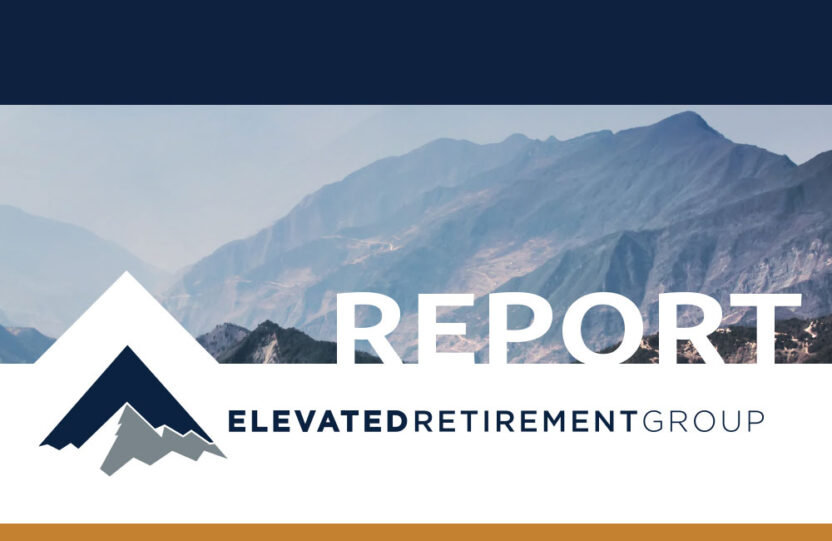
Report: Second Quarter Economic Update
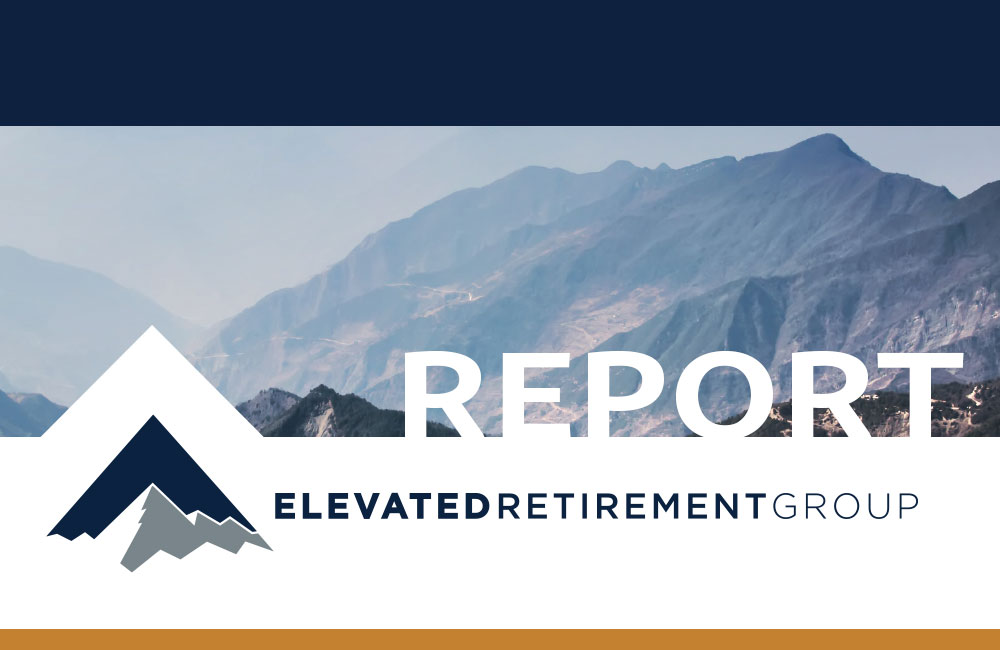
A new US president and the winding down of most government-led pandemic safety measures welcomed investors to 2021.
As we experienced the reopening of many countries, volatility appeared in the equity markets but resulted in new market highs in the second quarter. The S&P 500 has now gained ground for five quarters in a row. Notably, it has gained more than 5% for five quarters in a row, only the second time since 1945 that the index has been able to pull off that feat. The previous occasion was in 1954, according to Bespoke Investment Group, a time when the Fed was also trying to emerge from a period of ultralow interest rates. Needless to say, through a whirlwind of change, investors who stayed the course could have experienced a continued drive toward better economic and financial health. (Source: Barron’s 6/2021)
“Better news on Covid, vaccinations, re-openings, economic growth, and earnings fueled the advance. Nearly equal gains were achieved in both quarters by a rotation in leadership allowing broad participation,” said Jim Paulsen, Leuthold Group’s Chief Investment Strategist. (Source: cnbc.com 06/30/2021)
On the last day of Quarter 2, the S&P 500 rose 0.1% to end at 4,297. This marked the S&P 500’s 24th record close of 2021. The Dow Jones Industrial Average (DJIA) closed 210.22 points higher at 34,502, a gain 0.6%. This close was just 1% shy of its May 7 record close of 34,777.76. (Source: marketwatch.com 7/1/2021)
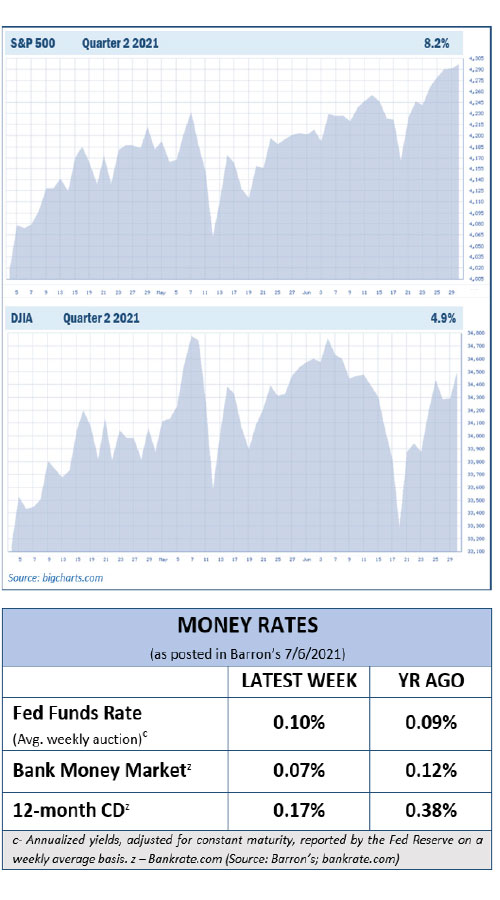
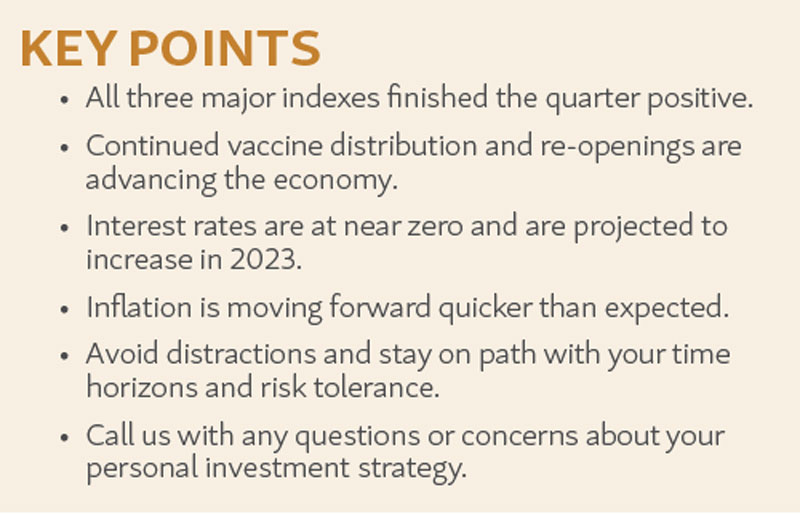
Historically, positive first halves of the year are usually followed by positive second halves. If there is a double-digit gain in the first half both the S&P 500 and the DJIA have never ended the year with an annual decline according to Refinitiv data dating back to 1950. (Source: www.cnbc.com 06/29/2021)
However, amidst all the positive momentum toward recovery, there is still concern about the condition of the job market, inflation, and uncertainty about the path of the virus and the severity or impact that new strains may have. Theoretically speaking, the stock market tends to be a forward-looking mechanism, so its price can reflect an economic recovery well before it actually occurs. With COVID variants and many potential challenges still ahead, investors need to continue being watchful.
As a financial professional, it is our goal to stay apprised of the issues that we feel may directly impact you and your financial goals. We will be keeping a watchful eye on the progress of the economic recovery.
Inflation & Interest Rates
Two of the most talked about issues at the end of the second quarter were inflation and interest rates.
In June, the Federal Reserve held their two-day meeting and concluded that due to more aggressive inflation than expected this year, they anticipate raising interest rates sooner than previously expected. Back in March 2021, the Fed expected not to raise rates until at the earliest, 2024. At its June meeting, the Fed’s latest dot-plot projections moved the timeline to potentially 2023, where there could possibly be two interest rate hikes.
Powell also stated, “The dots are not a great forecaster of future rate moves ... it’s because it’s so highly uncertain. There is no great forecaster -- dots to be taken with a big grain of salt,” he said. (Source: www.cnbc.com 06/16/2021)
Bond yield percentages also pulled back from their high. 10-year treasury yield last traded at 1.56% on June 16 after Powell’s remarks.
Inflation is a real concern for savers because it eats into purchasing power and lifestyle. While we are nowhere near the last 90 years highest or lowest periods of inflation, investors still should try to at least keep pace with or exceed inflation rates.
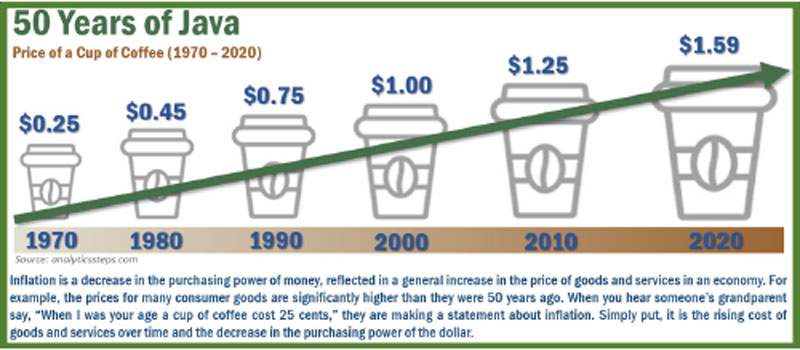
Treasury Yields
During the quarter, longer-term Treasury yields moved sharply higher, with the yield on the benchmark 10-year U.S. Treasury note jumping from 0.93% to 1.74%, its highest level since early 2020. At quarter’s closing, the 10-year treasury yield was 1.456% and the 30-year treasury yield was 2.08%. (Source: cnbc.com 06/30/2021)
Interest rates are still at or near all-time lows and rates of 0 to 2% will not help many investors reach their goals. Also, during periods of rising interest rates, bond prices fall. Interest rates are critical when creating a diversified and balanced portfolio, therefore, investors need to pay attention to interest rate movements.
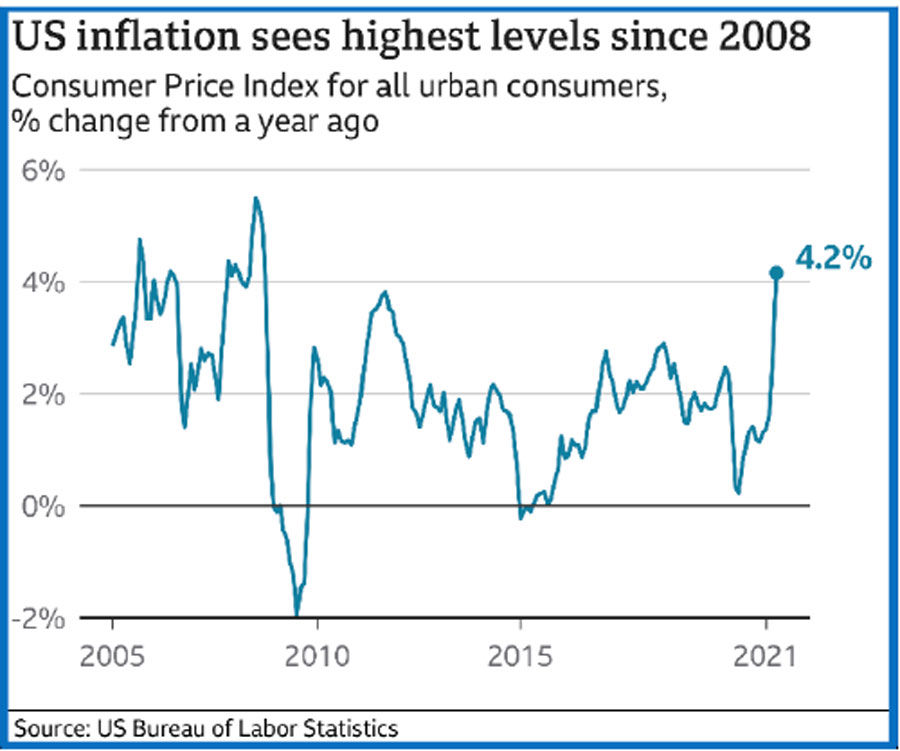
Investor’s Outlook
With the swift distribution of vaccines and the subsequent lifting of restrictions, the economy is seeing a dramatic uptick and is positioned to recover even more in the coming months. While equity markets are still looking favorable, all eyes are on inflation. This may cause some volatility in stocks.
Although history is just data and cannot be predictive of future events, as mentioned earlier, historically, a positive first half of the year has traditionally brought a positive second half.
Blackrock, one of the world’s largest asset managers in their midyear report noted that, “We remain constructive on U.S. stocks as the economic restart gains pace. Yet as the cycle evolves, investors will increasingly divert their attention toward the potential party spoilers. A chief concern is inflation, and whether the rising prices seen in some pockets of the economy are transitory or the first signs of an enduring new regime. We expect fears of inflation will be enough to stoke volatility in stocks, even amid Fed assurances of continued accommodation. Similarly, tax policy may become a volatility trigger as lawmakers debate the proposal”. (Source: Blackrock.com 7/1/2021)
Seeking Alpha in their midyear outlook shares, “A chief concern is inflation, and whether the rising prices seen in some pockets of the economy are transitory or the first signs of an enduring new regime.” They also remind us that equity markets are forward looking and they share that inflation and taxes could bring market volatility in this year’s second half. (Source: Seeking Alpha.com 6/25/2021)
Investors understand that it is not what you make, but what you keep, so another area we will be paying careful attention to is proposed new tax policy. With interest rates still near ultra-low levels, investors need to examine the use of equities in their portfolios. With equities at or near all-time highs, investors need to fully understand their personal timelines and risk appetites. Our role as financial professionals is to help find the right balance for our clients so they can pursue their goals.

We still advise to proceed with caution. Regardless of how equities are performing, investors should always focus on their personal objectives and long-term goals. Even when investing for the long-term, there is no guarantee that market volatility will decrease, stabilize, or increase over any timeframe. While you cannot control the return on investment you will see, there are 3 things you can control, and of which should be your main focus:
1. Your risk tolerance
2. Your time horizon
3. Your behavior
Our advice is not one-size-fits-all. We will always consider your feelings about risk and the markets and review your unique financial situation when making recommendations. If you would like to discuss your specific investment holdings or risk tolerance, please call or email our office. If you ever have any concerns or questions, please contact us.

